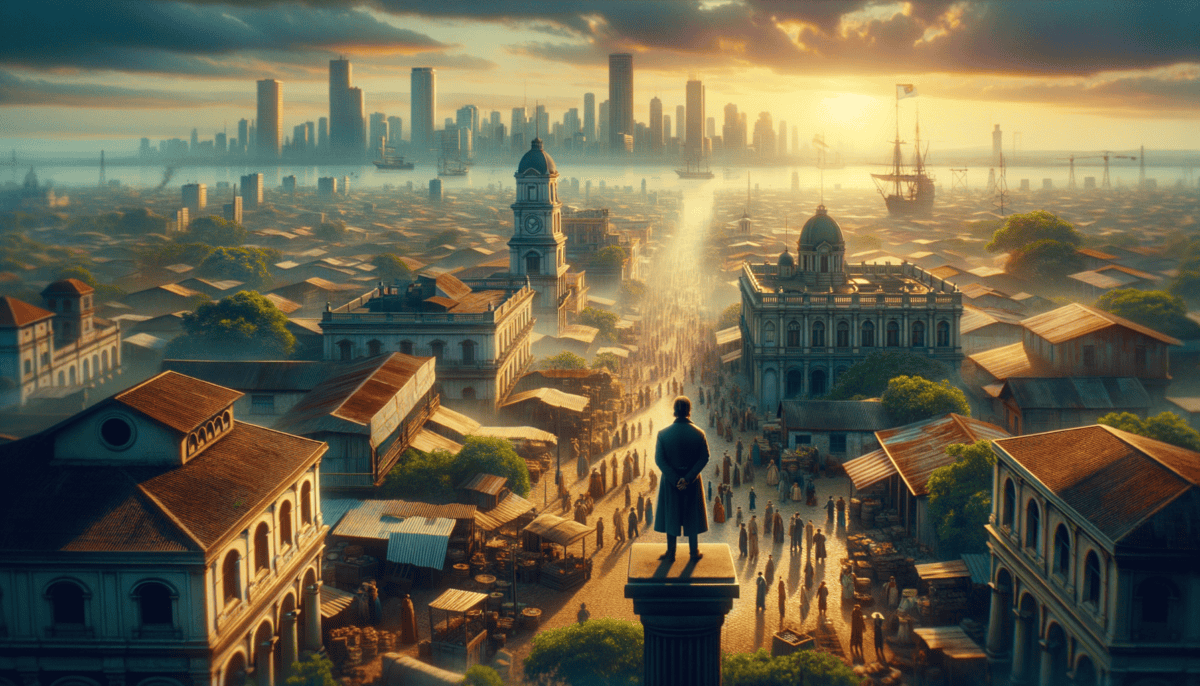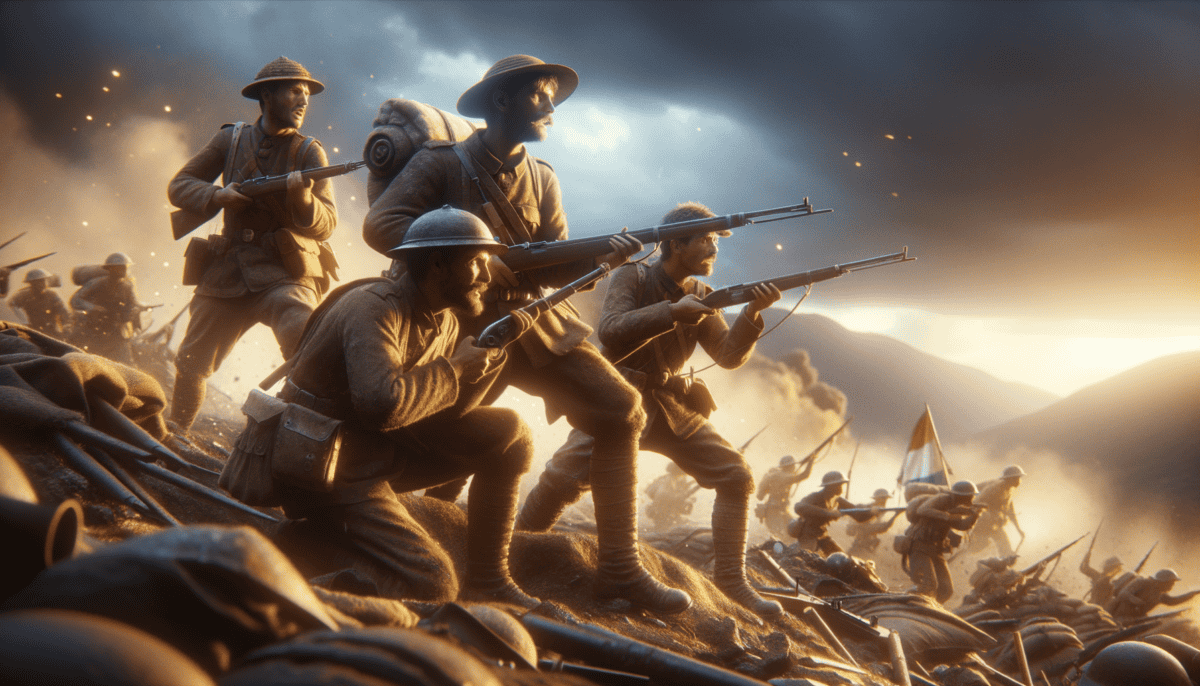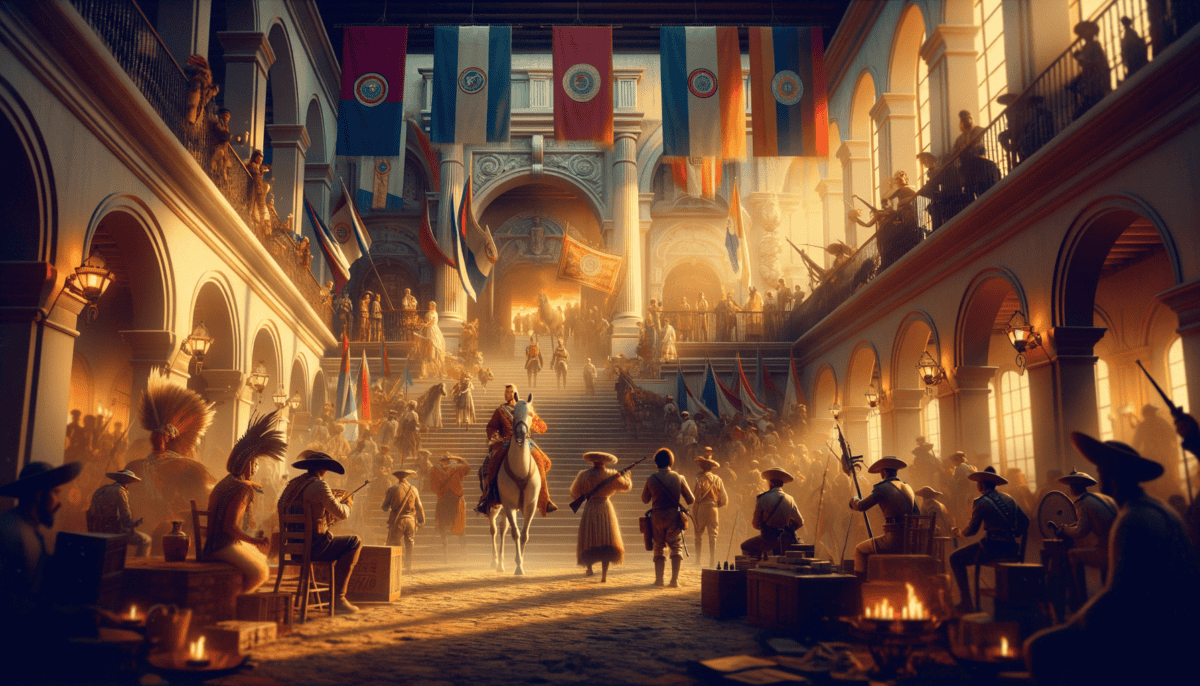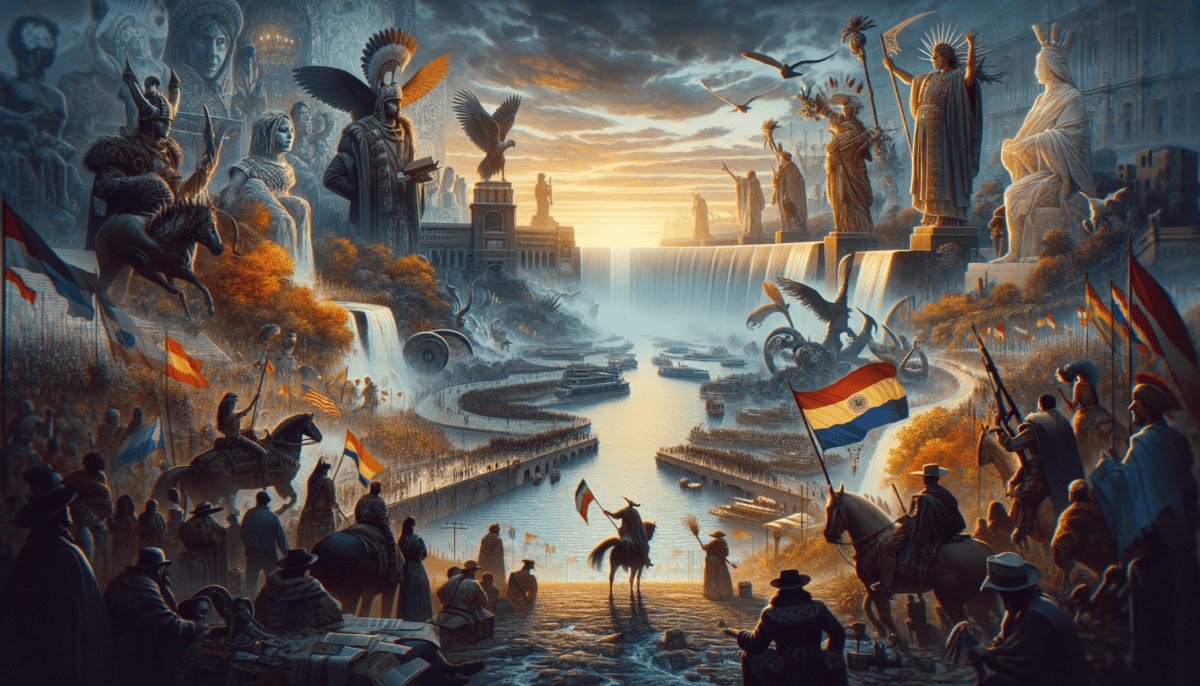Roots of Resilience
Deep in the heart of South America, where mighty rivers flow like veins through lush green forests, lived the brave Guarani people. They called this beautiful land their home long before it became Paraguay.
"Grandmother, tell us about our ancestors!" little María begged, sitting cross-legged on the wooden floor of their cozy home in Asunción.
Grandmother Ana smiled warmly, her eyes twinkling with ancient wisdom. She began to weave a tale as rich as the land itself:
“Our Guarani ancestors were masters of the forest. They knew every plant, every animal, and lived in harmony with nature. They built their homes from strong wood and palm leaves, and worked together like one big family.”
The Guarani people had special ways of living that made them strong:
- They grew corn and sweet potatoes
- They shared everything with their community
- They spoke their own special language
- They were brave warriors when needed
- They knew how to use plants as medicine
"But one day," Grandmother Ana continued, her voice growing serious, "strange men with shiny armor and tall ships came from across the big ocean. These were the Spanish conquistadors."
Young María's eyes grew wide. "Were our people scared, Grandmother?"
"No, mi amor. The Guarani were brave. Some fought against the Spanish, while others found ways to work with them. This is why today, we still speak both Spanish and Guarani – we're special that way!"
The Spanish brought new things: horses , cattle , and different ways of building houses. But the Guarani kept their important traditions alive. They taught the Spanish about the forest's secrets and how to survive in this land.
"It wasn't always easy," Grandmother Ana explained, "but our people were smart. Instead of fighting all the time, many Guarani learned to blend their ways with the new ways. That's why today, we have such a rich culture!"
María touched the colorful embroidery on her dress – a pattern that told stories from long ago. "Is that why we still make these beautiful designs?"
"¡Exactamente! Exactly!" Grandmother beamed. "We keep our old stories alive through our art, our language, and our hearts."
The sun began to set outside their window, painting the sky in beautiful oranges and purples. But the story of Paraguay was just beginning. The Guarani spirit of strength and wisdom would help their descendants face many more challenges in the years to come.
María yawned, but her eyes still sparkled with curiosity. "Tomorrow, will you tell me more about our history, Grandmother?"
"Of course, mi amor," Grandmother Ana replied, patting María's head gently. "There are many more amazing stories about our beautiful Paraguay to share."
The warm evening breeze carried the sweet smell of jasmine through the window, just as it had done for countless generations before. In homes across Paraguay, other grandmothers were telling similar stories, keeping their heritage alive one tale at a time.
The Unusual Dictator
The sun was rising over Asunción when María rushed to her grandmother’s side. “Tell me more about our history!” she exclaimed. “What happened after the time of the Guarani?”
Grandmother Ana settled into her favorite chair. “Ah, mi amor, let me tell you about one of the most interesting leaders Paraguay ever had – Dr. José Gaspar Rodríguez de Francia. People called him ‘El Supremo.’ ⚖️”
“In 1811, when Paraguay became free from Spain, we needed someone strong to lead us. Dr. Francia was different from other rulers. He was very smart and loved to read books. “
María leaned forward, curious. “What made him so special, Grandmother?”
“Well, mijita, he did things that seemed strange to others but helped Paraguay grow strong. Here are some of his clever ideas:
- He made Paraguay like a giant farm where everyone had to grow food
- He started free schools for poor children
- He made sure everyone had land to live on
- He kept Paraguay safe by not letting other countries boss us around ️
- He helped poor people have better lives
“But the most amazing thing,” Grandmother continued, her eyes twinkling, “was that under Dr. Francia, Paraguay became like a big family that took care of itself.”
“Did he build things too?” María asked, remembering how much she loved to play with building blocks.
“¡Sí! He built new roads, bridges, and schools. He was like a strict father who wanted his children to be strong and independent.” ️
Grandmother Ana reached for her mate tea, a tradition that went back to those times. “Some people thought Dr. Francia was too strict. He didn’t let people leave Paraguay easily, and he wanted everyone to follow his rules.”
“Like when you tell me to clean my room?” María giggled.
“Kind of!” Grandmother laughed. “But his rules helped Paraguay grow strong. While other countries were fighting wars, our people were peaceful and had enough food to eat.”
The afternoon light filtered through the window as Grandmother continued, “Dr. Francia made sure Paraguay didn’t need help from other countries. We made our own clothes, grew our own food, and built our own houses.”
“That sounds smart!” María nodded wisely.
“Yes, it was. Even though some people didn’t like his strict ways, Dr. Francia helped make Paraguay strong and independent. He ruled for almost 30 years!”
Outside, birds sang in the mango trees, just as they had during Dr. Francia’s time. María could almost imagine seeing him riding through the streets of Asunción on his white horse, checking to make sure everyone was working hard and following the rules.
“What happened after Dr. Francia?” María asked, eager to hear more.
Grandmother Ana took another sip of her mate tea. “Ah, that’s another exciting story. After him came more leaders who built on what he started. But Paraguay would soon face its biggest challenge ever…”
The afternoon shadows grew longer as María thought about the unusual dictator who had helped make her country strong. She felt proud knowing that Paraguay had found its own special way to grow and succeed, just like the beautiful orange trees in their garden that grew tall and strong with proper care.
War and Sacrifice
As the evening stars began to twinkle, María snuggled closer to her grandmother. “You said Paraguay faced a big challenge. What happened next?”
Grandmother Ana’s face grew serious. “It was 1864, mi amor. Paraguay had grown strong, but three big countries – Brazil, Argentina, and Uruguay – joined together against us. “
“But why did they fight us, Abuela?” María asked, her eyes wide.
“They didn’t like how strong Paraguay was becoming. Our president, Francisco Solano López, wanted Paraguay to have a path to the sea. But the other countries said no.”
“Our people fought like lions, mijita. Even the women helped! They worked in the fields, made clothes for soldiers, and took care of the wounded. Some even fought in battles!”
“Really? The women fought too?” María sat up straighter, proud to hear about the brave women.
“Yes! Let me tell you about the *Residentas* – the brave women who sold their jewelry to help buy weapons. And the *Destinadas* who worked in the hospitals.” ⚔️
Grandmother paused to wipe a tear. “Almost every family lost someone they loved. Paraguay fought for six long years, even when things seemed impossible.”
The most amazing acts of bravery happened during this time:
- Children fought beside grown-ups
- Women farmed while men were at war
- Everyone shared what little food they had
- People used tree bark to make clothes
- Soldiers fought with wooden weapons when metal ones ran out ️
“What happened in the end, Abuela?” María whispered.
“We lost many battles, dear one. But we never lost our spirit! Even when the enemy was much bigger, our people kept fighting.”
Grandmother held María’s hand tightly. “After the war, Paraguay had to start over. We lost land, and many, many people were gone. But do you know what’s amazing?”
“What, Abuela?”
“The people who survived didn’t give up. They began rebuilding right away. Like ants rebuilding their anthill after a storm.”
María thought about this. “Is that why you always tell me to keep trying when things are hard?”
Grandmother smiled proudly. “¡Exactamente! That’s exactly right. Our history teaches us to be strong and never give up.”
The moon was rising now, casting silver light through the window. “The war changed Paraguay forever, but it also showed how brave our people are. We learned to work together and help each other.”
“Like when my friends and I help clean up the playground?” María asked.
“Yes, mi amor. Just like that. Working together makes us strong.” ❤️
As crickets chirped outside, María thought about the brave people who had fought so hard. She felt proud to be Paraguayan, knowing her people never gave up, even when times were very hard.
“Abuela,” she said sleepily, “tell me about how Paraguay got better after the war…”
Rising from the Ashes
María’s eyes sparkled with curiosity. “What happened after the big war, Abuela? How did Paraguay get better?”
Grandmother Ana smiled gently. “Ah, mijita, that’s when our people showed their true strength. Like a garden after winter, Paraguay began to bloom again.”
“First, we needed more people to help rebuild our country. So Paraguay invited friends from other places to come live here.”
“People came from Italy, Germany, and Spain. They brought new ideas and helped make Paraguay strong again,” Grandmother explained, her voice warm with pride.
María bounced excitedly. “Like my friend Isabella’s family! They came from Italy!”
“¡Exactamente! And do you know what made our rebuild special?” Grandmother asked.
The most important things that helped Paraguay grow again were:
- New farms to grow food
- Schools to teach children
- Roads to connect towns ️
- Stores to sell things
- Banks to save money
“The women were extra special heroes,” Grandmother continued. “They worked very hard to build new homes and teach children. They kept our stories and traditions alive.”
María hugged her doll close. “Like you tell me stories, Abuela?”
“Yes, mi amor! Stories help us remember who we are. The women made sure we didn’t forget our Guaraní language and culture.”
“Something amazing happened during this time,” Grandmother said with a twinkle in her eye. “Paraguay started making beautiful lace called ñandutí. Have you seen it?”
“Yes! Like the pretty tablecloth we use for special days!” María clapped her hands.
“That’s right! Making beautiful things helped heal our hearts. We also started growing more yerba mate tea.” ☕
Grandmother pulled out an old photo album. “Look, these are pictures from when I was little. See how different things looked?”
María studied the black and white photos. “The buildings look smaller, Abuela!”
“They were! But year by year, we built bigger buildings. We made new roads. We planted more crops. Everyone worked together.” ️
“Like building with blocks?” María asked. “When you add one at a time?”
“¡Exacto! Just like that. Step by step, Paraguay grew stronger. We learned that hard times can’t break us when we help each other.”
The evening breeze carried the sweet smell of jasmine through the window. Grandmother wrapped her arm around María.
“But rebuilding wasn’t always easy,” she continued softly. “Sometimes people disagreed about how to make things better. But they learned to work together, just like you and your friends at school.”
“Each person did their part. Farmers grew food. Teachers taught children. Builders made houses. And slowly, our country became strong again.”
María yawned and snuggled closer. “We’re still strong now, right Abuela?”
“Sí, mi amor. And do you know what made us even stronger? Another big challenge was coming – the Chaco War…”
Warriors of the Chaco
María sat up straight, suddenly wide awake. “A new war, Abuela? But why?”
Grandmother Ana held her granddaughter close. “It was 1932, mijita. Bolivia and Paraguay both wanted the same land – a wild place called the Chaco.” ️
“Was it scary?” María whispered, clutching her doll.
“At first, everyone was worried. Bolivia had more soldiers and better weapons. But do you know what Paraguay had?”
The key things that helped Paraguay win were:
• Brave soldiers who knew the land
• Smart leaders who made good plans
• Special trucks that could drive in sand
• Help from all the people at home
• Strong hearts that never gave up
“Your abuelo fought in that war,” Grandmother said softly, touching an old photograph. “He told me how they used clever tricks to win.”
“We learned to fight smart, not just hard,” he used to say. “When we couldn’t match their tanks, we made special paths through the bushes.”
María traced the photograph with her finger. “Did the trucks help win the war, Abuela?”
“¡Sí! We got special trucks that could drive through the sandy Chaco. The Bolivian tanks would get stuck, but our trucks kept going!”
“The war was hard, but everyone helped,” Grandmother continued. “Women made clothes and food for the soldiers. Children collected metal for trucks. Even the youngest helped!”
María sat taller. “Like when we all help clean the classroom?”
“Exactly like that! Working together makes big jobs easier.”
Grandmother pulled out a small medal from her memory box. “This was your abuelo’s. He got it for being brave.”
“It’s so shiny!” María’s eyes widened. ✨
“The war lasted three years,” Grandmother continued. “Our soldiers were tired and thirsty, but they never gave up. They protected our land.”
“Did we win, Abuela?”
“Yes, mi amor. Paraguay won most of the Chaco land. But the most important thing we won was pride in ourselves.”
“After the war, people felt strong again. They knew Paraguay could do amazing things, even when others said we couldn’t.”
“Like David and Goliath?” María asked, remembering her Sunday school story.
“¡Exactamente! Just like that. Paraguay was smaller, but we were smart and brave.”
“The victory changed how people saw Paraguay,” Grandmother explained. “Other countries started paying attention to us again. We weren’t just the little country that lost a big war anymore.”
María hugged her grandmother tight. “I’m proud to be from Paraguay!”
“Me too, mi amor. And there’s still more to our story. Wait until you hear about the big dam we built…”
The Power of Progress
“Tell me about the dam, Abuela!” María bounced excitedly on her grandmother’s lap. “The one you mentioned!”
Grandmother Ana smiled, pulling out a colorful postcard showing a massive wall of concrete stretching across a mighty river. “This is the Itaipu Dam, mi amor. It’s one of the biggest things humans have ever built!”
“Is it really that big?” María’s eyes widened with wonder.
“¡Sí! When we built it with our friends from Brazil in the 1970s, people said it was impossible. But Paraguay loves proving people wrong!”
“Just like the Chaco War, we showed what our country can do when we work together,” Grandmother said proudly.
María traced the river in the picture. “Does the dam help people?”
“Oh yes! It gives us clean power and helps our economy grow strong. But that’s not all Paraguay has achieved!”
Grandmother pulled out her phone, showing María pictures of modern Paraguay:
• Beautiful modern cities
• Strong farming and business
• People who speak both Spanish and Guarani
• Happy families keeping old traditions alive
• New technology helping everyone
“Look at Asunción now!” Grandmother showed her a photo of the capital city’s sparkly skyline. “When I was young, we didn’t have these tall buildings!” ️
María clapped her hands. “It’s so pretty!”
“And you know what makes me most proud?” Grandmother asked, touching the colorful tejido patterns on María’s dress. “We keep our special Guarani culture alive while moving forward.” ❤️
“Like how we speak Guarani at home?” María asked.
“¡Exactamente! We’re one of the only countries where almost everyone speaks both Spanish and an indigenous language. That’s very special!” ️
Grandmother hugged María close. “Your generation will write the next chapter of Paraguay’s story. What do you dream for our country?”
María thought for a moment. “I want to help build more cool things like the dam! And teach everyone about our special stories!” ⭐
“Those are beautiful dreams, mi amor. Paraguay’s story is like our beloved tereré – refreshing, unique, and shared with love.”
As the sun set outside their window, casting warm golden light across the city, Grandmother Ana smiled at her granddaughter. “Remember, María, our country may be small on the map, but our hearts are giant. We’ve faced big challenges and come back stronger every time.”
“That’s what makes us Paraguay!” María declared proudly.
“Yes, mi amor. And our story continues, getting better every day. Want to know why?”
“Why, Abuela?”
“Because the spirit of Paraguay lives in brave hearts like yours.”






